Mic 102 exam 1 questions Study guides, Class notes & Summaries
Looking for the best study guides, study notes and summaries about Mic 102 exam 1 questions? On this page you'll find 53 study documents about Mic 102 exam 1 questions.
All 53 results
Sort by
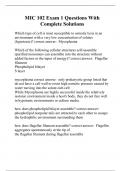
-
MIC 102 Exam 1 Questions With Complete Solutions
- Exam (elaborations) • 9 pages • 2023
- Available in package deal
-
- $10.49
- + learn more
MIC 102 Exam 1 Questions With Complete Solutions
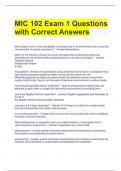
-
MIC 102 Exam 1 Questions with Correct Answers
- Exam (elaborations) • 6 pages • 2023
- Available in package deal
-
- $12.99
- + learn more
MIC 102 Exam 1 Questions with Correct Answers Which type of cell is most susceptible to osmotic lysis in an environment with a very low concentration of solutes (hypotonic)? - Answer-Mycoplasma Which of the following cellular structures self-assemble (purified monomers can assemble into the structure without added factors or the input of energy)? - Answer-Flagellar filament Phospholipid bilayer S layer mycoplasma - Answer-only prokaryotic group listed that do not have a cell wall to ...

-
MIC 102 Exam 1 Questions with Correct Answers
- Exam (elaborations) • 6 pages • 2023
- Available in package deal
-
- $10.49
- + learn more
MIC 102 Exam 1 Questions with Correct Answers Which type of cell is most susceptible to osmotic lysis in an environment with a very low concentration of solutes (hypotonic)? - Answer-Mycoplasma Which of the following cellular structures self-assemble (purified monomers can assemble into the structure without added factors or the input of energy)? - AnswerFlagellar filament Phospholipid bilayer S layer mycoplasma - Answer-only prokaryotic group listed that do not have a cell wall to res...
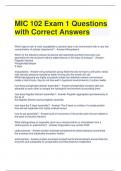
-
MIC 102 Exam 1 Questions with Correct Answers
- Exam (elaborations) • 6 pages • 2024
- Available in package deal
-
- $11.99
- + learn more
MIC 102 Exam 1 Questions with Correct Answers Which type of cell is most susceptible to osmotic lysis in an environment with a very low concentration of solutes (hypotonic)? - Answer-Mycoplasma Which of the following cellular structures self-assemble (purified monomers can assemble into the structure without added factors or the input of energy)? - Answer- Flagellar filament Phospholipid bilayer S layer mycoplasma - Answer-only prokaryotic group listed that do not have a cell wall to r...
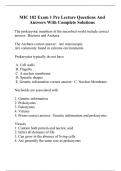
-
MIC 102 Exam 1 Pre Lecture Questions And Answers With Complete Solution
- Exam (elaborations) • 13 pages • 2023
- Available in package deal
-
- $10.49
- + learn more
MIC 102 Exam 1 Pre Lecture Questions And Answers With Complete Solution
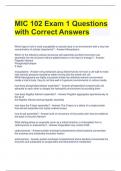
-
MIC 102 Exam 1 Questions with Correct Answers
- Exam (elaborations) • 6 pages • 2024
- Available in package deal
-
- $9.39
- + learn more
MIC 102 Exam 1 Questions with Correct Answers Which type of cell is most susceptible to osmotic lysis in an environment with a very low concentration of solutes (hypotonic)? - Answer-Mycoplasma Which of the following cellular structures self-assemble (purified monomers can assemble into the structure without added factors or the input of energy)? - AnswerFlagellar filament Phospholipid bilayer S layer mycoplasma - Answer-only prokaryotic group listed that do not have a cell wall to res...
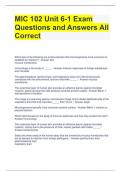
-
MIC 102 Unit 6-1 Exam Questions and Answers All Correct
- Exam (elaborations) • 6 pages • 2023
- Available in package deal
-
- $13.99
- + learn more
MIC 102 Unit 6-1 Exam Questions and Answers All Correct Which two of the following are surface barriers that microorganisms must overcome to establish an infection? - Answer-skin mucous membranes Immunology is the study of _____. - Answer-immune responses to foreign substances and microbes The gastrointestinal, genitourinary, and respiratory tracts are internal structures connected with the environment, and are lined with _____. - Answer-mucous membranes The outermost layer of huma...
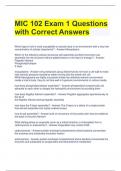
-
MIC 102 Exam 1 Questions with Correct Answers
- Exam (elaborations) • 6 pages • 2023
- Available in package deal
-
- $8.79
- + learn more
MIC 102 Exam 1 Questions with Correct Answers Which type of cell is most susceptible to osmotic lysis in an environment with a very low concentration of solutes (hypotonic)? - Answer-Mycoplasma Which of the following cellular structures self-assemble (purified monomers can assemble into the structure without added factors or the input of energy)? - AnswerFlagellar filament Phospholipid bilayer S layer mycoplasma - Answer-only prokaryotic group listed that do not have a cell wall to res...
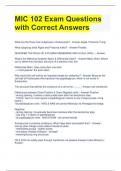
-
MIC 102 Exam Questions with Correct Answers
- Exam (elaborations) • 17 pages • 2023
- Available in package deal
-
- $13.99
- + learn more
MIC 102 Exam Questions with Correct Answers What are the three main subgroups of Eukaryotes? - Answer-Algae, Protozoa, Fungi What subgroup does Algae and Protozoa make? - Answer-Protists DESCRIBE THE ROLE OF A PLASMA MEMBRANE AND A CELL WALL. - Answer- What's the difference between Basic & Differential Stain? - Answer-Basic Stain: Allows you to determine the basic structure of a bacteria (rod, etc) Differential Stain: Uses more than one stain --> most popular: the gram stain. ...
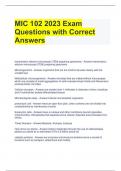
-
MIC 102 2023 Exam Questions with Correct Answers
- Exam (elaborations) • 12 pages • 2023
- Available in package deal
-
- $14.49
- + learn more
MIC 102 2023 Exam Questions with Correct Answers transmission electron microscope (TEM) preparing specimens - Answer-transmission electron microscope (TEM) preparing specimens Microorganisms - Answer-organisms that are too small to be seen clearly with the unaided eye Multicellular microorganisms - Answer-microbes that are visible without microscopes which are consists of small aggregations of cells example bread molds and filamentous photosynthetic microbes Cellular microbes - Answ...

$6.50 for your textbook summary multiplied by 100 fellow students... Do the math: that's a lot of money! Don't be a thief of your own wallet and start uploading yours now. Discover all about earning on Stuvia


